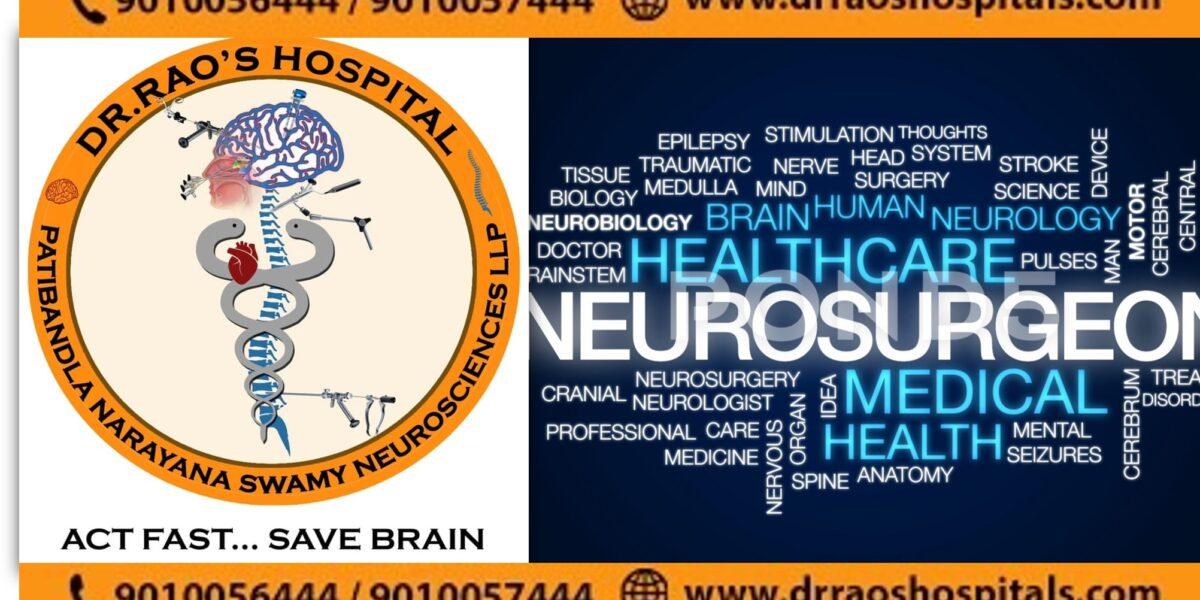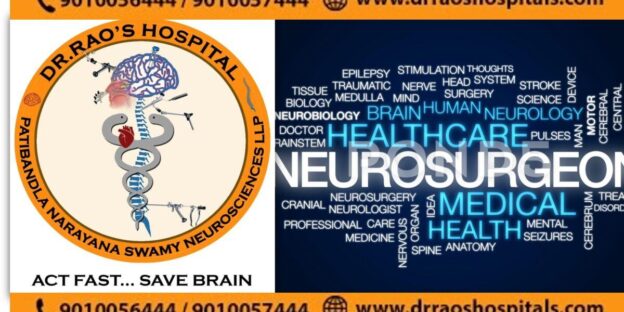Common neuro problems – the best treatment at Dr Raos, Guntur
Neurology is a branch of medicine that focuses on diagnosing and treating disorders of the nervous system, including the brain, spinal cord, and nerves. Some common topics in neurology include:
- Stroke: A stroke is a life-threatening, debilitating health event that occurs when the vital blood supply to the brain is disrupted, resulting in permanent damage to the brain tissue. There are two leading causes of stroke – blockages in the blood vessels, known as ischemic stroke, or bleeding in the brain, known as hemorrhagic stroke. Symptoms of stroke can vary depending on the area of the brain that has been affected and can include paralysis, difficulty speaking, and loss of vision. It is absolutely vital to be aware of the various signs and symptoms of stroke as quickly as you can, as the earlier treatment is started, the more probable it is that the outcome will be positive. The signs to look out for include sudden numbness of the face, arm, or leg, blurred vision, confusion, difficulty speaking, and severe headaches. If any of these are experienced, it is important to dial 9010056444 or 90100574444 immediately and seek prompt medical assistance.
- Epilepsy: Epilepsy is a serious neurological disorder that is characterized by recurrent and unpredictable seizures. Seizures are episodes of abnormal electrical activity in the brain that can be accompanied by convulsions, loss of consciousness, and strange changes in behavior. Seizures can last for only a few seconds or for several minutes, and can range from mild to severe in intensity. People living with epilepsy may experience seizures multiple times a day, or just once or twice a year. Epilepsy can be a debilitating condition, with devastating effects on a person’s physical and mental health. Treatment of the epilepsy typically involves a combination of medication and lifestyle modifications. Medications used to treat epilepsy may include anticonvulsants, antiepileptic drugs, or sedatives. In some cases, surgical intervention may be necessary to control the epileptic activity. In addition, lifestyle modifications such as avoiding triggers that can cause seizures, eating a healthy diet, and exercising regularly may help to reduce the frequency and severity of seizures.
- Multiple sclerosis (MS): Multiple Sclerosis (MS) is a chronic and often debilitating autoimmune disorder that affects the central nervous system. It is characterized by inflammation and damage to the myelin sheath, a protective insulating layer surrounding nerve fibers in the brain and spinal cord. This damage to the myelin sheath disrupts the normal transmission of nerve impulses, resulting in a wide range of possible symptoms, ranging from mild to severe. Common MS symptoms include vision problems, numbness, muscle weakness, and difficulty with coordination, balance, and speech. The cause of MS is unknown, but is thought to involve a combination of genetic and environmental factors. Diagnosis of MS involves a physical exam, neurological exam, MRI, and laboratory tests. Treatment of MS is aimed at reducingsymptoms and slowing the progression of the disease. Medications such as interferon beta, gling disease-modifying therapies, immunosuppressants, and corticosteroids may being the activity of the immune system. Other treatments may include physical therapy, occupational therapy, speech therapy , and cognitive behavioral therapy. In some cases, surgery may be recommended to help improve mobility and reduce pain. Medications such as nonsteroidal anti-inflammatory drugs, antispastic medicationss and muscle relaxants may be prescribed to help reduce pain and improve mobility. Physical therapy exercises may be “and stretching may be recommended to help strengthen muscles. Other treatments such as massage, acupuncture, and heat or cold therapy may be used to help reduce inflammation. In some cases, surgery may be necessary to correct the underlying cause of the mobility issue. Physical therapy can also help to improve balance, strengthen muscles, and increase range of motion. Exercises may be prescribed to help improve posture and improve coordination. Other treatments may include the use of assistive devices such as canes, walkers and wheelchairs, as well as physical therapy modalities such as heat, cold, ultrasound, and electrical stimulation. Occupational therapy may also be recommended to help with activities of daily living, such as dressing, bathing, eating, and grooming. Speech therapy may be recommended to help with communication and swallowing Speech therapists may also work on cognitive skills, such as memory, problem solving, and organization. Physical therapists may be recommended to help with mobility and balance. Occupational therapists may be recommended to help with activities of daily living, such as dressing, bathing, and eating. Speech-language pathologists may be recommended to help with communication and swallowing. Mental health professionals may be recommended to help with cognitive and behavioral issues. Occupational therapists may be recommended to help with activities of daily living, such as dressing and bathing, as well as to help with fine motor skills. Physical therapists may be recommended to help with strengthening and coordination. Speech therapists may be recommended to help with communication and swallowing difficulties.
- Parkinson’s disease: Parkinson’s disease is a progressive neurological disorder that affects movement, causing many symptoms, such as tremors, stiffness, slow movement, and balance issues. It is caused by the loss of nerve cells in the brain that produce a chemical called dopamine, which helps regulate movement and is essential for coordination and communication between the brain and muscles. People with Parkinson’s disease may experience a range of symptoms, including tremors, slowed movement, impaired balance, rigidity, and difficulty initiating movement. Over time, Parkinson’s disease can also cause changes in cognition, behavior, and emotion. Treatment for a variety of ailments and conditions usually involves a comprehensive approach, including a combination of medications, physical therapy, and lifestyle changes. Medications may include both Over-the-counter and prescription drugs are important medicines that are used to treat various ailments and health conditions. OTC drugs, such as those for pain relief, cold and flu symptoms, and allergies, can be purchased without a prescription at any drugstore, grocery store, or convenience store. Prescription drugs, on the other hand, are usually more potent medicines that require a doctor’s prescription. These medicines can help with chronic conditions like diabetes and high blood pressure, and can also be used to treat infections or serious illnesses such as cancer. Both types of drugs can be incredibly helpful in treating and managing health issues, but they should always be taken as prescribed by a medical professional., while physical therapy can include activities such as stretching, strength training, and aerobic exercises. Additionally, lifestyle changes, such as quitting smoking, reducing stress, and eating a healthy diet, can help improve overall health and well-being.
- Alzheimer’s disease: Alzheimer’s disease is a debilitating and progressive neurological disorder that affects memory, thinking, behavior, and day-to-day functioning in older adults. It is the most common form of dementia, a general term for memory loss and other cognitive abilities serious enough to interfere with daily life. Though the precise cause of this incurable illness remains unknown, age, genetics, and lifestyle choices have been identified as potential contributing factors. Diagnosis of Alzheimer’s disease typically involves a physical exam, a review of medical history, and a variety of cognitive and neurological tests to assess memory, thinking, language, judgment, and other mental functions. Imaging tests such as computed tomography (CT) or magnetic resonance imaging (MRI) may also be used to rule out other conditions that could be causing the symptoms. Blood tests may be used to check for certain metabolic or infectious diseases that could be causing the symptoms. Other tests such as electroencephalography (EEG) or electromyography (EMG) may be used to check for nerve or muscle disorders. Treatment of AD involves medications to help manage symptoms, lifestyle changes, and therapies to help improve cognitive and behavioral functioning.
- Headaches: Headaches are a pervasive neurological disorder that can be caused by a variety of underlying factors, such as muscle tension, sinus problems, eyestrain, and food sensitivities. In some cases, headaches can be indicative of a more serious underlying medical issue, so it’s important to consult a physician if the symptoms become severe or persistent. Common symptoms of a headache include a throbbing or pounding sensation in the head, sensitivity to light and noise, nausea, fatigue, and difficulty focusing. Fortunately, there are a variety of treatments and lifestyle modifications that can help alleviate symptoms and reduce the frequency of headaches. Some of these include relaxation techniques, proper hydration, avoidance of trigger foods, and regular exercise. Additionally, medications and supplements such as ibuprofen, aspirin, and magnesium can help reduce the severity and frequency of headaches.
- Traumatic brain injury (TBI): Traumatic Brain Injury (TBI) is an injury to the brain caused by a sudden, violent impact or blow to the head, usually occurring during a car accident, a fall, a sports injury, or an act of violence. The severity of the injury can range from mild to severe and can cause a range of symptoms, including changes in consciousness, confusion, memory problems, difficulty with concentration or comprehension, and difficulty with movement or coordination. TBI can also lead to long-term complications such as headaches, sleep disturbances, speech or language difficulties, depression, and even personality changes. Diagnosis of Traumatic Brain Injury (TBI) typically involves a comprehensive physical examination conducted by a qualified medical professional. During this exam, the doctor will ask questions about the patient’s medical history, recent head injury and current symptoms. The physical exam may also include a physical evaluation of the patient’s cognitive abilities and motor functioning, as well as neurological tests. In addition, imaging tests such as CT scans or MRI scans may be used to help diagnose TBI. Treatment of the TBI involves either conservative or Surgical management.
These are just a few of the many topics that fall under the umbrella of neurology. Other areas of focus within the field include sleep disorders, movement disorders, nerve and muscle disorders, and developmental disorders.


